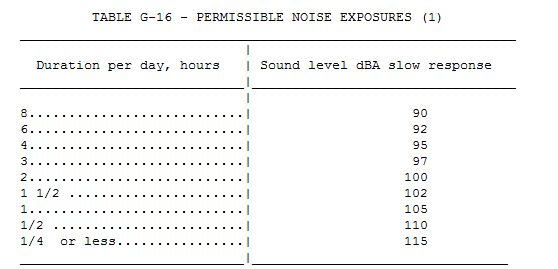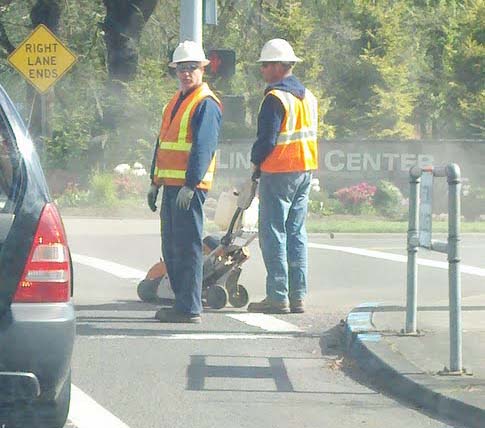Entries tagged with “construction”.
Did you find what you wanted?
Wed 30 May 2012
Posted by admin under Hearing Conservation, hearing protection, Noise
Comments Off on Noise Monitoring – FAQ / Q&As
I get the best questions from employees as I’m setting them up to wear a dosimeter. (FYI- this does not really apply to sound level readings, only dosimetry)
- Why do I have to wear the monitor (dosimeter)? Can’t we just place it in the middle of the area?
Ideally we want the dosimeter to measure the individual exposure. Many factors influence the average noise level, including work practices, location (sound bouncing & dampening), height, proximity to others, equipment, etc.
- What is the dosimeter actually measuring?
A dosimeter measure the sound pressure level, measured in decibels A-weighted, dBA (usually). It can record this level and average it (usually) for every 1 minute period. The amount of information it gathers is staggering…and confusing.
- What if we work a longer shift (more than 8 hours) will the results of the noise monitoring be the same?
Yes, the results are (usually) given as an average. So, in theory, if you measure the noise for 15 minutes and it is the same for the next 7.75 hours, it should be the same. However, if you work more than 8-hours a day OSHA actually decreases the amount of noise you can be exposed to. They have a table (G-16)  that attempts to explain it.  If you know the average level of noise (say it’s an average of 95 dBA 8-hour TWA), then you can determine the time you are allowed (answer: 4 hours).
- How often should noise monitoring be performed?
There is not a specific rule from OSHA on how often you must monitor. However, the guideline is yearly. Â Or if/when significant changes occur “which might effect the results of this testing” (I always use this statement in my reports).
- Which individual employees should have their noise level measured?
It is best to let the industrial hygienist make this determination (there are several good reasons). If you are just starting out, they will often choose an average, or those who might have the highest noise level exposures.
- I’m wearing hearing protection, why don’t they take that into account when they determine the average readings?
Your exposure is determined without regard to the specific type of hearing protection used. If you are wearing the wrong type of hearing protection, or if it is worn incorrectly, you could still have this exposure.
Wed 23 May 2012
Construction and exposure to Hepatitis B (or C or HIV) doesn’t arise very often since construction workers are usually not around blood, bodily fluids, or patients. There are times when construction must occur at wastewater treatment facilities, municipals, or in active sewers. Occasionally exposure can come from illegal drug use or the remnants of it (think of a project underneath a downtown bridge).
Currently there is not a specific rule for bloodborne pathogens in construction (1926). However, if it is reasonably anticipated that an employee might have exposure, you should take precaution.
What are the dangers? First, you must have occupational exposure to skin, eye, or mucous membrane with contact to blood or infected material.  Exposure may then cause the employee the diseases of Hepatitis B, C and HIV. Occasionally construction companies want to know if they need to offer their employees the Hep B vaccine.
The real-threat is contact with blood. Here is a question to ask… Do you anticipate seeing any blood on the jobsite? If the answer is NO…then you probably are under what is called the COLLATERAL DUTY clause.  In this case, the hepatitis B vaccination does not need to be given…until the presence of blood. Once this happens (and employees must be trained beforehand) you have certain steps to take in order to offer the Hep B vaccination. Oregon OSHA (and others) have adopted this stance.
In this case, the hepatitis B vaccination does not need to be given…until the presence of blood. Once this happens (and employees must be trained beforehand) you have certain steps to take in order to offer the Hep B vaccination. Oregon OSHA (and others) have adopted this stance.
If you have probable exposures you must:
- make an exposure control plan
- train your employees
- universal precautions – google it…there’s a lot to know
- protect your employees (engineering controls, work practices)
- housekeeping – cleanup
- label
- keep records
Oregon OSHA has some good info here.
Tags: biohazard, bloodborne pathogens, city, construction, HepB, HepC, HIV, safe, safety, sewer, treatment, vaccination, vaccine, waste water
Thu 10 May 2012
In  the trainings I perform for employers, I try to explain to them that there IS overexposure to silica on their jobsite. I tell them that if I could be at their site everyday, and be ready to perform air monitoring at a moments notice, I could find overexposures.
Here is an example of a road crew cutting asphalt with a concrete saw. I’m sure it was a small cut (since they were not a concrete cutting subcontractor, and it was a tiny little saw). But the haze you see is the dust plume from the cutting.
I just happened to drive by and be stopped at a red light when this occurred. I know, I probably shouldn’t have touched my phone (while in my car) to take a picture…but I couldn’t resist. And, with that same train of thought, the road construction crew probably thought, “it’s just a small cut and it will only take 5 minutes”. So, neither of us are innocent
 .
.
Fri 13 Apr 2012
Posted by admin under EPA, Lead, OSHA
[2] Comments
Who has jurisdiction over lead based paint? Are the EPA’s lead rules all I need to follow? Or, do I follow OSHA?
Well, the short answer (for those in construction) is YES. Usually OSHA, but maybe both EPA and OSHA (*and others, HUD, etc).
OSHA’s focus (as I’m sure you know) is to protect employees. If you are removing leaded on your own home, OSHA has no jurisdiction. However, if you have employees and are working with lead based paint, you must follow OSHA.
The EPA is focused on the environment (of course). They have implemented (April 22, 2008) a rule called the Renovation, Repair & Painting Rule. This rule applies when you are working on any facility which effects kids under the age of 6. If you are contractor looking to work on a project (s) with this demographic, you need to be certified by the EPA. Here is a good starting spot.
It is interesting (maybe just to me) but the EPA has very little enforcement, compared to OSHA. Yet, most people are very aware of the EPA rule. In contrast, I find contractors working with leaded paint who don’t know that they are under OSHA’s rules. I suppose the EPA has done a great job of marketing.
Another interesting comparison is that the EPA and OSHA rules are actually very similar. There are differences, but in general, if you are following the OSHA rules correctly, you are most likely very close to complying with the EPA. (one difference: the EPA requires certification)



